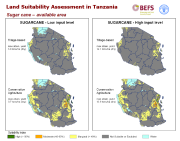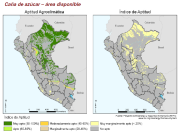sugarcane
Type of resources
Available actions
Topics
Keywords
Contact for the resource
Provided by
Formats
Representation types
Update frequencies
status
-

This dataset presents the result of the Bioenergy and Food Security (BEFS) analysis for Tanzania on land suitability and availability for sugarcane. In particular it reports the available area suitable for sugarcane production at different levels of suitability, considering specific production systems and level of inputs. Land already under agriculture production or protected or environmentally sensitive has been excluded from the land suitability total area, in order to get a true understanding of which lands are available for bioenergy production in this country. Please note that the "Excluded areas" layers, used to identify areas that in Tanzania could not be available for bioenergy activities, are also described in this catalogue. You may find the link to them in the Distribution Information section of this metadata. The land suitability index categorizes the capability of a specific location to achieve the maximum attainable yield in percentage terms. The maximum attainable yield is defined as the harvested yield of a high-producing variety with “constraint-free†conditions (water, nutrients and pests and disease), which can be achieved under a specific production system and level of inputs. This dataset shows the result of the assessment carried out for the sugarcane under two production systems, namely Tillage-based (TA) and Conservation agriculture (CA) and under low and high inputs. The two production systems and two input levels result in four agricultural configurations: 1 - Tillage-based at low inputs (TA-L) 2 - Tillage-based at high inputs (TA-H) 3 - Conservation agriculture at low inputs (CA-L) 4 - Conservation agriculture at high inputs (CA-H) The BEFS analysis has also investigated the following crops for potential bioenergy development: cassava, palm oil, sweet sorghum and sunflower. All BEFS results have been reported in the FAO publication “Bioenergy and Food Security - The BEFS Analysis for Tanzania†and the final products made available in this catalogue.
-

Yield for the year 2010 for wheat, cotton and sugarcane under rain-fed, irrigated and total water supply conditions. The Yield dataset, at about 5 km resolution, is part of the GAEZ v4 Actual Yields and Production - Area, Yield and Production sub-theme. For additional information, please refer to the GAEZ v4 Model Documentation.
-

This dataset presents the result of the Bioenergy and Food Security (BEFS) analysis for Peru on land and agro-climatic suitability and availability for sugarcane. In particular it reports the available area suitable for sugarcane production at different levels of suitability, considering the tillage-based (TA) production system, high level of inputs and existing irrigation systems. Land already under agriculture production or protected or environmentally sensitive has been excluded from the land suitability total area, in order to get a true understanding of which lands are available for bioenergy production in this country. Please note that the "Excluded areas" layers, used to identify areas that in Peru could not be available for bioenergy activities, are also available in this catalogue. You may find the link to them in the Distribution Information section of this metadata. The land suitability index categorizes the capability of a specific location to achieve the maximum attainable yield in percentage terms. The maximum attainable yield is defined as the harvested yield of a high-producing variety with “constraint-free†conditions (water, nutrients and pests and disease), which can be achieved under a specific production system and level of inputs. In Peru the analysis of Land Suitability Assessment (LSA) was held also for oil palm and white pinion (Jatropha) under two production systems, namely Tillage-based (TA) and Conservation agriculture (CA) and under low and high inputs. The two production systems and two input levels result in four agricultural configurations: 1 - Tillage-based at low inputs (TA-L) 2 - Tillage-based at high inputs (TA-H) 3 - Conservation agriculture at low inputs (CA-L) 4 - Conservation agriculture at high inputs (CA-H) Source data: MINAG, 2008. Series histórica de producción agrícola. http://frenteweb.minag.gob.pe/sisca/?mod=consulta_cult All BEFS results have been reported in the FAO publication “Bioenergía y seguridad alimentaria - El análisis de BEFS para el Perú - Compendio técnico Vol I y II†and the final products made available in this catalogue.
-

Production for the year 2010 for wheat, cotton and sugarcane under rain-fed, irrigated and total water supply conditions. The Crop Production dataset, at about 5 km resolution, is part of the GAEZ v4 Actual Yields and Production - Area, Yield and Production sub-theme. For additional information, please refer to the GAEZ v4 Model Documentation.
 FAO Map Catalog
FAO Map Catalog